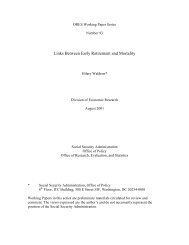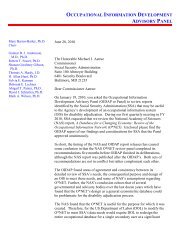in the chart, especially for men, the changing compositionof claimers after age 65 and more clearly afterthe FRA, which should be considered to be 66 startingin 2004 for the purposes of Table 8. The break in thepost-65 series in 2000 is striking. We also observe thetrend toward some convergence to pre-2000 levels ofbenefits, again especially for men (Chart 3).The statistical significance of the differences by sexand age are explored in Table 9. That analysis showsthat for men, the changes in the benefit levels for thoseclaiming after age 65 have been especially sharp inthe post-2000 period; the much lower benefits sincethe elimination of the earnings test contrast with manyyears in which the benefit levels for those claiming atages 66–69 were not statistically significantly differentfrom the levels of those claiming at age 65 in 1994.One final important result is the significantly higherbenefit levels among men claiming at age 62 (and alsoat ages 63–65) starting in 1999, compared with thoseclaiming at age 65 in 1994, likely resulting from thecomposition of those claiming early after the implementationof the increases in the FRA. This effectseems to be much smaller for women.ConclusionsThis article uses microdata from the OASDI publicusemicrodata extract of 2004 to analyze the effectson retirement benefit claiming behavior and level ofbenefit receipt of a number of changes to the <strong>Social</strong><strong>Security</strong> system implemented in the past few years.These changes include increasing the full retirementage, increasing the delayed retirement credit, and abolishingthe earnings test for persons above the FRA.We find evidence of a large and significant shortruneffect of abolishing the earnings test on theclaiming behavior of older Americans. There is alsoevidence of a significant, and much longer-lived effecton the composition of those claiming benefits afterage 65 in the post-2000 period, with much loweraverage benefits for late claimers compared with thoseclaiming at other ages. Both effects are stronger formen than for women. We also find evidence of significanteffects resulting from the changes in the FRA,leading to an increase in the benefit levels among earlyretirees, coupled with a fairly large proportion of individualsthat still wait to exactly reach the FRA to file,which likely predicts a sizable shift of the traditionalage-65 retirement benefit claiming peak toward age 66(and eventually even age 67) in the coming years.Additionally, there is evidence that the effects of theincreases in the DRC seem to be very small.Key to our analysis are the concepts of actuarialfairness and self-selection, which allow us to overcome,to a high degree, the impossibility to control forobserved individual heterogeneity, as it is usually donein most micro-level analyses of retirement. The factthat individuals self-select themselves into claimingat different ages, given the well-known adjustmentsto their lifetime benefits if they choose to claim atan age that is not the FRA, allows us to extract considerableinformation from the data sources we useand provide a surprisingly sharp picture of the likelyeffects of policy changes―effects that have been hardto pinpoint by researchers using household-level data.Although it would be ideal to be able to control for amuch larger array of observables in order to explainthe changes we see in the data, we believe that even ifthis were possible, our main results would not changesignificantly.Our analysis is not able to illuminate one key aspectintimately linked with claiming behavior and benefitlevels, and that is labor supply. Some recent data suggestan increase in the labor force participation amongolder Americans, but to disentangle the sources ofthese changes will quite likely require fairly sophisticatedmodels of behavior, using household-level datamatched to <strong>Social</strong> <strong>Security</strong> administrative records.Those models should be able to match the patterns ofclaiming behavior and benefit levels we have describedin this analysis.Our findings should encourage researchers to usethe public-use data provided by SSA. This data sourcecan complement more traditional analyses usinghousehold-level data and provide useful benchmarksfor researchers modeling retirement behavior usingadvanced econometric and computational methodsof analysis.AppendixTable A-1 shows the actual PIAs for the same groupof individuals as shown in Table 3. Table A-2 is thecounterpart of Table 5, providing the t-statistics toassess the magnitude of the differences between allthe numbers in Table A-1 and the reference cell.90 <strong>Social</strong> <strong>Security</strong> Bulletin • Vol. 69 • No. 3 • 2009
Table A-1.Average PIA of new claimants of <strong>Social</strong> <strong>Security</strong> retirement benefits, by age, 1994–2004 (in 2005 dollars)Age 1994 1995 1996 1997 1998 1999 2000 2001 2002 2003 200462 940.78 926.23 935.13 953.19 973.71 1,034.55 1,046.03 1,080.50 1,127.71 1,142.03 1,103.0163 979.89 1,009.24 992.26 1,004.17 1,026.54 1,030.67 1,089.22 1,098.32 1,123.75 1,165.74 1,121.9564 1,018.19 1,021.65 1,047.72 1,013.85 1,012.43 1,039.77 1,061.02 1,135.15 1,154.62 1,165.67 1,181.9465 1,057.93 1,058.15 1,058.74 1,078.11 1,054.01 1,061.43 1,099.92 1,122.12 1,170.74 1,181.23 1,141.3566 1,136.01 1,026.72 1,101.08 1,053.64 1,121.91 1,124.77 1,232.29 887.25 856.65 986.29 1,172.3967 1,000.67 1,039.73 1,058.21 1,047.50 1,011.88 1,115.41 1,240.26 830.71 888.67 840.90 942.8868 1,001.07 941.18 977.90 969.08 992.46 1,078.06 1,222.81 845.29 757.86 751.68 796.6769 1,155.27 1,150.30 1,009.65 981.93 990.41 1,082.81 1,153.82 879.90 844.02 718.22 843.33SOURCE: OASDI public-use microdata file, 2004.NOTE: Shading is used to emphasize differences by age group.Table A-2.t-statistics of PIA of new claimants of <strong>Social</strong> <strong>Security</strong> retirement benefits, by age, 1994–2004Age 1994 1995 1996 1997 1998 1999 2000 2001 2002 2003 200462 -20.942 -24.2018 -23.1928 -19.2652 -15.3388 -4.106 -2.0489 3.7583 10.8637 13.3432 7.782763 -7.9977 -5.0899 -6.7459 -5.5853 -3.2251 -2.7561 3.1105 3.8991 6.1921 9.6267 5.852964 -2.7804 -2.4186 -0.6552 -2.8275 -3.0307 -1.2372 0.2103 5.0466 6.1515 6.5032 7.834365 a 0.0343 0.1227 3.0688 -0.6182 0.5818 7.4898 11.3957 19.3562 20.07 12.405966 2.5193 -1.0137 1.7775 -0.1488 2.2147 2.6307 9.5604 -3.7035 -5.077 -1.6894 7.957167 -1.2032 -0.385 0.0076 -0.261 -1.2481 1.7761 7.6716 -4.8227 -2.9185 -4.0269 -1.826868 -1.0134 -1.9625 -1.6702 -1.8942 -1.4107 0.482 5.1924 -3.7229 -5.8324 -5.6851 -4.968369 1.6174 1.6602 -1.0627 -1.3864 -1.435 0.5483 2.5446 -3.3092 -4.1866 -6.7483 -3.5572SOURCE: OASDI public-use microdata file, 2004.NOTE: The shaded cells represent significance at the 5 percent level or higher. Bold type is used to emphasize differences by age group.a. The corresponding cell from Table A-1 is used as the comparison to test the equality of means with the rest of the cells in Table A-1.NotesAcknowledgments: We are grateful to Frank Heiland,Lina Walker, and the participants in the Aging and <strong>Social</strong><strong>Security</strong> session at the APPAM Conference in Washington,DC, who provided excellent comments and suggestions.Barbara Lingg, Christine Vance, Rona Blumenthal, JoyceManchester, and Kimberly Burham provided invaluablehelp dealing with the data set we use. Any remaining errorsare those of the authors. Hugo Benítez-Silva acknowledgesthe financial support from Grant No. 5 P01 AG022481-04from the National Institute on Aging and the Spanish Ministryof Science and Technology, through project numberSEJ2005-08783-C04-01.1Notice, however, that with the sharply increasingearnings limit for those above the FRA starting in 1996,and the fact that the earnings test was eliminated for thoseaged 70–71 beginning in 1990, the change came in phases,even if the final removal was a policy item, the timing ofwhich was not easy to foresee.2In fact, the analysis of claiming behavior and benefitreceipt by cohorts, which because of the time span of thedata could only be partially completed, provide the samequalitative results. We consider this evidence of the robustnessof our results.3After age 70 there is little incentive to delay claimingbenefits given that the DRC provision stops at that time,and therefore any individual claiming after age 70 wouldreceive less in present value for any life expectancy or anylength of life he or she might have or end up having.4Our presentation here attempts to be as clear and simpleas possible and not necessarily comprehensive of all thepossible details and exceptions to the general rules of thesystem. For an encyclopedic presentation of the rules of thesystem we refer the reader to Myers (1993) and also to the<strong>Social</strong> <strong>Security</strong> Web site at http:/www.socialsecurity.gov.5The exempt amount for the period between the monthof benefit claiming and the year the person reaches theFRA was $13,560 in 2008: for every dollar earned abovethis limit the government withheld 50 cents of benefits.A higher exempt amount, $36,120, applies in the year ofattaining FRA for months before such attainment. For thelatter case the withholding rate is $1 for every $3 earnedabove this limit.<strong>Social</strong> <strong>Security</strong> Bulletin • Vol. 69 • No. 3 • 2009 91
- Page 1 and 2:
Social SecuritySocial SecurityBulle
- Page 3:
Social SecurityBulletin Vol. 69, No
- Page 6 and 7:
Perspectives77 An Empirical Study o
- Page 8 and 9:
Selected Abbreviations—continuedM
- Page 10:
within the next few years (Aglira 2
- Page 14 and 15:
coverage varies significantly by ra
- Page 16 and 17:
non-Hispanic white, and college edu
- Page 18 and 19:
same groups (Table 6). For the last
- Page 20 and 21:
from DB to DC pensions is accelerat
- Page 22 and 23:
Table 8.Percent of individuals who
- Page 24 and 25:
not necessarily the largest gains a
- Page 26 and 27:
shoring-up DB plans before those pl
- Page 28 and 29:
Table B-1.Percent change in mean pe
- Page 30 and 31:
Table B-3.Percent of individuals wh
- Page 32 and 33:
ReferencesAaronson, Stephanie, and
- Page 35 and 36:
Social Security Administration’s
- Page 37:
Chart 1.Historical expansion of Soc
- Page 40 and 41:
self-employment information for the
- Page 42 and 43:
(Cronin 1985). The final earnings r
- Page 44 and 45:
prior to 1950, first year of earnin
- Page 46 and 47: average indexed monthly earnings (A
- Page 48 and 49: 13For an explanation of how the sel
- Page 50 and 51: Kopczuk, Emmanuel Saez, and Jae Son
- Page 53 and 54: Occupations of SSI Recipients Who W
- Page 55 and 56: on the differences between the occu
- Page 57 and 58: prediction models. Table A-1 lists
- Page 59 and 60: Occupational Distributions of theEm
- Page 61 and 62: similar, only 4 percent of the popu
- Page 63 and 64: Table 5.Estimated occupational dist
- Page 65 and 66: Table 7.Predicted Herfindahl-Hirsch
- Page 67 and 68: Table 9.Estimated occupational dist
- Page 69 and 70: Table 11.Average annual wages of wo
- Page 71 and 72: Table A-2.Means and standard errors
- Page 73 and 74: Table A-3.Coefficients and standard
- Page 75 and 76: Table A-3.Coefficients and standard
- Page 77 and 78: Table A-3.Coefficients and standard
- Page 79 and 80: management, professional, and relat
- Page 81: Stapleton, David C., Nanette Goodma
- Page 84 and 85: Selected Abbreviations—continuedO
- Page 86 and 87: The 1983 Amendments to the Social S
- Page 88 and 89: Chart 1.Proportion of new claimants
- Page 90 and 91: Table 4.The evolution of the ARF an
- Page 92 and 93: for the test of equality of means b
- Page 94 and 95: Table 8.Average monthly Social Secu
- Page 98 and 99: 6This is a very important character
- Page 100 and 101: Benítez-Silva, Hugo, Berna Demiral
- Page 103 and 104: OASDI and SSI Snapshot andSSI Month
- Page 105 and 106: Monthly Statistical Snapshot, Augus
- Page 107 and 108: Table 2.Recipients, by eligibility
- Page 109 and 110: SSI Federally Administered Payments
- Page 111 and 112: Table 7.Average monthly payment, by
- Page 113: Awards of SSI Federally Administere
- Page 116 and 117: Copyright—Authors are responsible
- Page 119 and 120: Program Highlights, 2009Old-Age, Su








